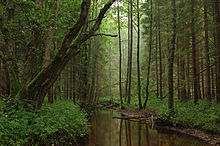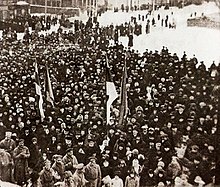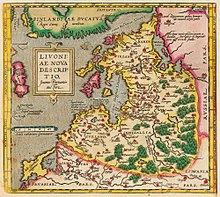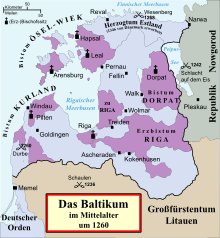Estonia
![]()
Eesti is a redirect to this article. For the former US automobile manufacturer, see Eesti Motorcar Manufacturing Company.
Template:Infobox State/Maintenance/NAME-German
Estonia [ˈeːstlant; ˈɛstlant] (Estonian Eesti [ˈeːsʲti], officially Republic of Estonia, Estonian Eesti Vabariik) is a country in the Baltic States. As the northernmost of the three Baltic states, it borders Latvia to the south, Russia to the east, and the Baltic Sea to the north and west. There are close ties to Finland across the Gulf of Finland, and historically there are many cultural ties to Germany through the Baltic Germans.
First independent from 1918 to 1940 and again since 1991, Estonia is a member of the United Nations and has been a member of the EU since 2004. Estonia is also a member of the Council of Europe, NATO and the OSCE, since 2010 of the OWCE and since 2011 of the Eurozone.
Estonia has a population of just over 1.3 million (January 2018). The capital and largest city of Estonia is Tallinn, the second largest city is Tartu.
Geography
Estonia is located in the north of the Baltic States. The classification of the entire region, in turn, is controversial and is influenced not only by geographical factors but also by historical-cultural and political aspects. Thus, the Baltic States are assigned to Northern Europe as well as Central Europe, Eastern Europe and Northeastern Europe.
Estonia is located on the eastern coast of the Baltic Sea. In terms of area, it is slightly smaller than Lower Saxony and slightly larger than Switzerland. The lake-rich forest and hill country with many bogs (partly extraction of peat) has an average height of only 50 m. In the southeastern moraine area it rises to the Livonian hill country to the highest elevation, Suur Munamägi (318 metres). The largest lake is Peipsi järv (Lake Peipus), and the largest islands are Saaremaa and Hiiumaa.
The total coastline has a length of 3,794 kilometres. It is characterized by several gulfs (such as the Bay of Riga), straits and inlets.
See also: List of Estonian islands and List of cities in Estonia
Climate
The climate of Estonia is generally cool-moderate to harsh with cold, frosty winters and moderately warm summers at northern European levels. The annual mean temperature in the capital Tallinn is 4.5 °C, with 650 millimetres of precipitation with a maximum in late summer. The average temperature in July is 16.5 °C and -6.0 °C in January. Despite the cold winter, the coasts remain mostly ice-free.
flora and fauna
More than 50% of Estonia's land area is forested. The most common deciduous tree in Estonian forests is the birch. It is a much-sung motif in songs and folk poetry and a national symbol of the country. Scots pine is particularly common on sandy soils near the sea. It accounts for about 35% of Estonian forest area. Its importance is greatest on the offshore islands of Saaremaa and Hiiumaa and in Harjumaa County. Spruce, fir and larch are also among the coniferous species native to Estonia.
In Estonia, large mammals such as moose (approx. 12,000), red deer (approx. 2,800), roe deer (approx. 50,000), brown bear (approx. 600), lynx (approx. 800), wolf (approx. 150) and wild boar (approx. 20,000) are native and can be hunted. Furthermore, red foxes, beavers (about 20,000), martens (among others the European mink with about 25 specimens on Hiiumaa) and the rarer snow hares (about 12,000) occur.
The largest nature reserve in the country is Otepää looduspark (Otepää Nature Park) with about 222 km².
Estonia is of international importance as a breeding area for the double-crested snipe and as a migration area for many migratory birds. Furthermore, eight of the nine European woodpecker species breed in the country.

Gulf of Finland (satellite image)

Tarvasjõgi
History
→ Main article: History of Estonia
Today's Estonia consists of the former Baltic Sea province of Estonia, which belonged to the Russian Empire from 1710 to 1918, and the northern part of Livonia, which also included the island of Saaremaa (Ösel).
German influence
The vassals who had come to the country with the Teutonic Order had first united in 1252 to form an autonomous provincial administration, which was confirmed by the Danish Nordestland until 1346. After the end of the Order's rule in 1561, the Hanseatic towns and the knighthoods in the country took over the public-law self-government tasks. These land privileges, a kind of statute of autonomy, were confirmed by the Swedish sovereignty and remained untouched even after the Russian conquest of Estonia in the Great Northern War (1710).
The upper class of the city burghers and landowners was German-speaking, and until 1885 German was the language of instruction and the authorities. Due to a Russification campaign by the Russian Tsarist government, Russian replaced German in this function.
First independence
The University of Tartu (Dorpat) played a central role in the development of Estonia's own cultural and political identity. From the 1870s onwards, Estonian students at the University of Tartu consciously decided not to assimilate through membership of the Estonian corporate bodies, but to promote their own identity, especially in the Estonian Students' Association. During the disintegration of the Russian Empire in the course of the October Revolution, Estonia gained its independence on 24 February 1918. Women and men were granted universal suffrage in the electoral law of the Constituent Assembly of 24 November 1918, so that women's suffrage was introduced at the same time as men's suffrage. The Constitution of 1920 confirmed this right.
In 1921 Estonia became a member of the League of Nations.
In the years 1939 to 1940, the Baltic Germans were resettled in the German Reich by the National Socialists from Estonia and Latvia under the motto "Home to the Reich". The reason for this was the agreement reached in the secret treaty of the Hitler-Stalin Pact to assign the Baltic States to the Soviet sphere of interest.
Soviet Republic
Under massive pressure and threats of violence, Estonia, together with Latvia and Lithuania, was annexed by the Soviet Union in 1940 in accordance with the provisions of the German-Soviet Non-Aggression Pact, which delimited and defined the German and Soviet spheres of interest. According to Soviet reading, the Baltic states joined the USSR, however, an Estonian government-in-exile existed throughout the period of Estonia's affiliation with the USSR, the continuity of which is also recognized in Estonia's official interpretation today. Internationally, too, the annexation was largely unrecognized until the country's renewed independence. The Estonian Soviet Socialist Republic was proclaimed with the support of Soviet emissaries, after Estonia had previously had to tolerate Soviet troops on its territory. Women's suffrage remained.
In 1940/41 there were mass deportations of Estonians, especially from the propertied and educated middle classes, to the interior of the Soviet Union. Many of them perished in the Gulag penal camps. After the German invasion of the Soviet Union in 1941, the country was occupied by German troops until 1944 and was administratively assigned to the Reichskommissariat Ostland. During this time, the genocidal policy of the Nazi rulers against the Jews was also pursued in Estonia with the participation of locals. About 1,000 local Jews and about 10,000 Jews from Eastern and Central Europe were killed in the Holocaust.
Due to their experiences with the Soviet occupation forces, many Estonians joined the German troops, and Estonians also fought on the Soviet side. Tens of thousands of Estonians fled westward to Germany in 1944 (from there later to America and Australia), quite a few also to Sweden or Finland. After the renewed occupation by the Red Army in autumn 1944, the country was incorporated into the Soviet Union under restoration of the Estonian Soviet Socialist Republic of 1940/41. This was followed by further deportations of Estonians who were supposedly or actually opposed to the Soviet system and reprisals against so-called enemies of the people.
During the Second World War, the Swedish-speaking population, who had lived mainly on the islands of Hiiumaa (Dagö), Vormsi (Worms) and Ruhnu (Runö), also left the country. Until then, they had retained their Estonian Swedish, which, together with Finnish Swedish, is one of the East Swedish dialects.
In the period from 1945 to 1990, the composition of the population by nationality was changed significantly to the disadvantage of the native Estonian population through the targeted settlement of non-Estonian Soviet citizens, especially Russians.
Renewed independence in 1990
On 30 March 1990 Estonia declared itself a republic again.
On 18 December 1990 Estonia renounced further participation in the Supreme Soviet of the USSR. In a referendum held on 3 March 1991 on the future status of the republic, 78% of eligible voters voted in favour of independence. The Chairman of the Supreme Council of the Republic of Estonia, Arnold Rüütel, stated that a referendum had no legally binding effect. After the August coup in Moscow on 20 August 1991, the Supreme Council declared full independence from the Soviet Union. On August 23, 1991, the Soviet secret service KGB was banned, and on August 25, all organs of the Communist Party of the Soviet Union (CPSU) were banned. The Soviet Union recognised Estonia's independence on 6 September 1991.
Estonia thus restored its sovereignty after a process of several years of detachment from the Soviet Union - in the course of glasnost and perestroika, especially since 1988. This development was mainly peaceful; it became known as the "Singing Revolution". Women's suffrage was reaffirmed. Estonia became a member of NATO on 29 March 2004. The Estonian people supported accession to the European Union in a referendum on 14 September 2003. Estonia was subsequently admitted to the EU on 1 May 2004.
The country joined the OECD on 9 December 2010.
On 1 January 2011, Estonia became the first of the Baltic States to adopt the euro (see also Estonian euro coins).
A major problem for Estonia is the emigration of young and qualified inhabitants (mostly ethnic Estonians) to Scandinavia and Western Europe, with a constantly low birth rate.
See also: List of wars and battles in Estonia

At the Declaration of Independence in Pärnu on 23 February 1918.

Old map of Livonia Joannes Portantius, 1573

Livonian Confederation
Search within the encyclopedia